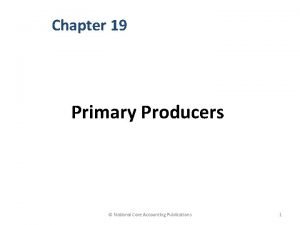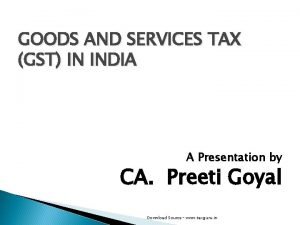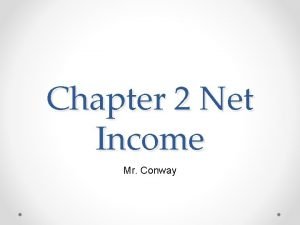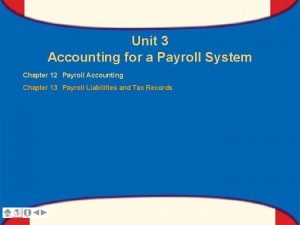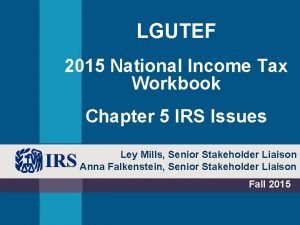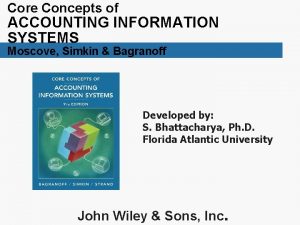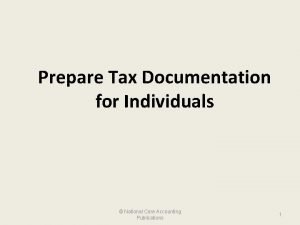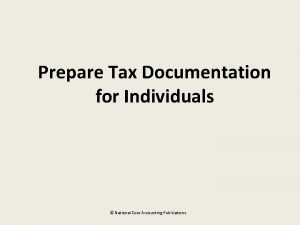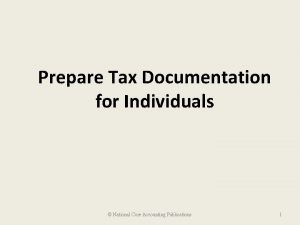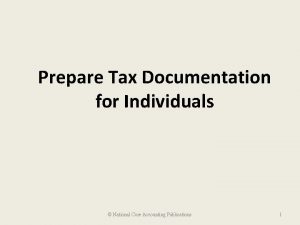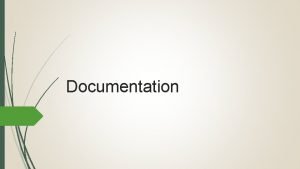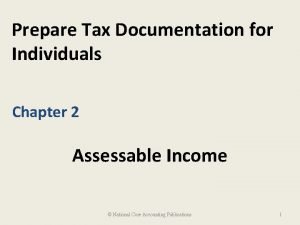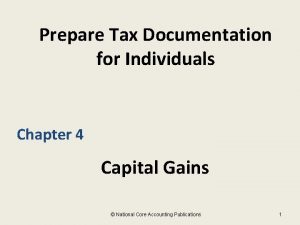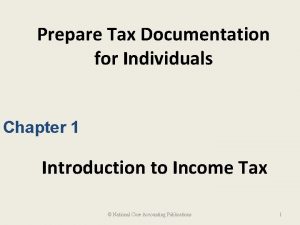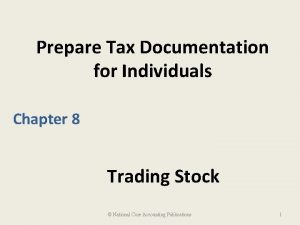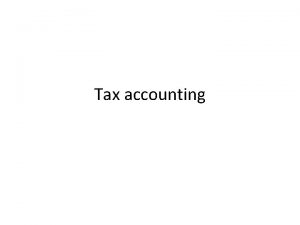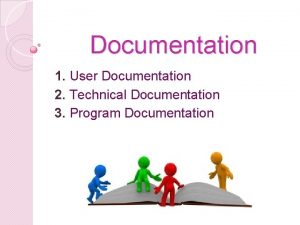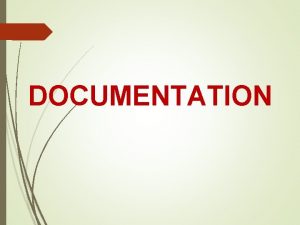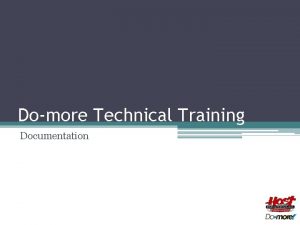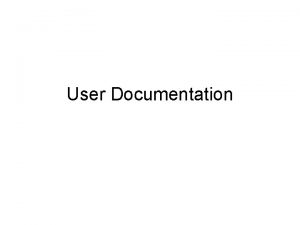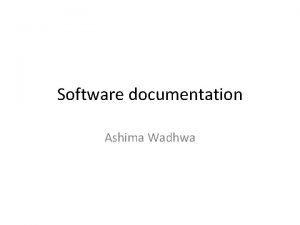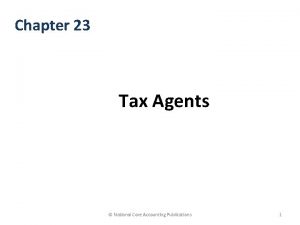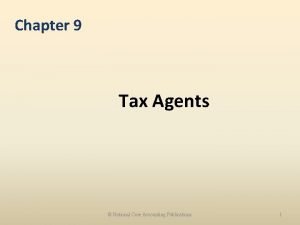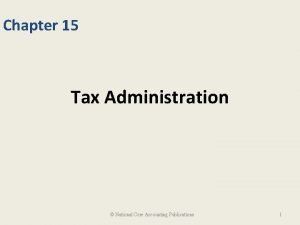Prepare Tax Documentation for Individuals National Core Accounting
















































- Slides: 48

Prepare Tax Documentation for Individuals © National Core Accounting Publications 1

Chapter 11 Decline in Value and Capital Allowances © National Core Accounting Publications 2

Overview s. 40 -25 allows a deduction for the decline in value of a depreciating asset that is held by the taxpayer at any time during the income year. The deduction is reduced to reflect the extent to which the asset was used for a purpose other than a taxable purpose (i. e. a private purpose). Where a depreciating asset is held only for part of a year, the decline in value is pro-rated. Note: The text book bases pro-rata calculations on whole months. In practice days are used. 3 © National Core Accounting Publications

Depreciating assets Definition s. 40 -30 defines a depreciating asset as: “an asset that has a limited effective life and that is reasonably expected to decline in value over the time that it is used. ” e. g. equipment, plant, machinery, intellectual property. 4 © National Core Accounting Publications

Basis for Decline in Value Decline in value is calculated based on the cost of the asset. The cost of an asset consists of a: First element of cost and Second element of cost 5 © National Core Accounting Publications

First element of cost Second of cost Is generally the consideration paid by the taxpayer for the asset. Is generally the consideration paid by the taxpayer to bring the asset to its present location and condition. 6 © National Core Accounting Publications

Choice of Method There are two methods of calculating decline in value for tax purposes: • Prime Cost method (PC) • Diminishing Value method (DVM) 7 © National Core Accounting Publications

Prime Cost Method (PC) Under the prime cost method, the annual decline in value of a depreciating asset is calculated as follows: Cost x days held Effective Life 365 * * 366 days in a leap year 8 © National Core Accounting Publications

Diminishing Value Method (DVM) Under the diminishing value method, the decline in value of a depreciating asset is calculated as follows: For assets acquired pre 10 May 2006 Base value x days held x 150% Effective Life 365 * * 366 days in a leap year © National Core Accounting Publications 9

Diminishing Value Method (DVM) Under the diminishing value method, the decline in value of a depreciating asset is calculated as follows: For assets acquired on or after 10 May 2006 Base value x days held x 200% Effective Life 365 * * 366 days in a leap year The DVM automatically applies unless the taxpayer elects to use the PC method. 10 © National Core Accounting Publications

Illustration: Comparison of Prime Cost and DVM A depreciating asset costing $10, 000 was acquired on 1 August 2015. It has an effective life of 5 years. Required: Calculate the decline in value for 2015/16 under both the Prime Cost and Diminishing Value methods. Solution: Prime Cost method 10, 000 x 11 5 12 = $1, 833 Diminishing Value method 10, 000 x 200% x 11 5 12 = $3, 667 Note: Whole months used for illustrative purposes. © National Core Accounting Publications 11

Disposal of Depreciable Assets Unless the termination value (i. e. selling price) of a depreciating asset exactly equals its adjustable value (i. e. written down value), then a balancing adjustment must be made. A balancing adjustment is calculated by comparing the termination value and the adjustable value of the asset. 12 © National Core Accounting Publications

Disposal of Depreciable Assets A balancing adjustment which is a loss on disposal is a deduction A balancing adjustment which is a gain on disposal is assessable income (i. e. where termination value is less than adjustable value) (i. e. where termination value is greater than adjustable value) 13 © National Core Accounting Publications

Illustration: Calculation of Balancing Adjustment (i) Termination Value < Adjustable Value A depreciating asset purchased on 1 July 2015 for $1, 000 was sold for $500 on 31 March 2016. Its decline in value was calculated using the prime cost method over 5 years. Therefore, the 2015/16 tax implications: • $350 balancing adjustment (loss on disposal) is a deduction. • $150 decline in value for the year up to date of disposal is a deduction. © National Core Accounting Publications 14

Illustration: Calculation of Balancing Adjustment (ii) Termination Value > Adjustable Value A depreciating asset with an Historical Cost of $24, 000 and an adjustable value of $20, 000 at date of disposal was sold for $22, 500. Therefore, the 2015/16 tax implications: • $2, 500 balancing adjustment (gain on disposal) is assessable income. • decline in value for the year up to date of disposal is a deduction. © National Core Accounting Publications 15

Illustration: Calculation of Balancing Adjustment (iii) Termination Value > Historical cost A depreciating asset (used wholly for business) costing $36, 000, with an adjustable value of $24, 500 at date of disposal was sold for $41, 000. Therefore, the 2015/16 tax implications: • $5, 000 gain on disposal is not subject to the capital gains tax provisions as capital gains on the sale of depreciating assets are disregarded. • $16, 500 (i. e. 41, 000 - 24, 500) balancing adjustment (gain on disposal), which is assessable income. • Decline in value for the year up to the date of disposal is deductible. © National Core Accounting Publications 16

Effective Life of Depreciating Assets The decline in value of a depreciating asset acquired on or after 1 July 2001 is calculated on the basis of the effective life of the asset. s. 40 -95 allows a taxpayer to either: • work out their own estimate of the effective life of a depreciating asset, or • rely on the ATO’s determination of effective life. 17 © National Core Accounting Publications

Effective Life of Depreciating Assets Taxpayer’s estimate of effective life: • must relate to the total estimated period the asset can be used for the purpose of producing assessable income. ATO’s estimate of effective life: • The ATO publishes recommended periods of effective life which taxpayers may adopt. 18 © National Core Accounting Publications

ATO’s Estimate of Effective Life • contains a list of assets under various industry Table A – Industry items categories. Effective Life • contains generic assets Table B – Asset listed alphabetically. Categories 19 © National Core Accounting Publications

Special Rates Low Cost items s. 40 -80(2) allows an immediate 100% deduction for depreciating assets costing $300 or less provided the asset was not part of a set whose total cost exceeded $300. This deduction is available only to non-business taxpayers (e. g. employees and landlords). 20 © National Core Accounting Publications

Balancing Charge Where Part-Business Use If the deduction for the decline in value of a depreciating asset is reduced because the asset was used partly for non-taxable purposes, then any assessable or deductible balancing adjustment is reduced by the fraction: sum of reductions total decline 21 © National Core Accounting Publications

Balancing Charge Where Part-Business Use Therefore, two calculations for decline in value arise: i. decline in value must be calculated as if the asset was fully used for business purposes, and ii. then calculated after deducting for the private usage component. 22 © National Core Accounting Publications

Illustration: Balancing Adjustment Under Part Business Use A taxpayer acquired a depreciating asset on 1 July for $4, 000 and used it 75% for income-producing purposes. Assume it has an effective life of 10 years and the prime cost method is used. Required: Calculate the decline in value and the reduction in any balancing adjustment over the first three income years. © National Core Accounting Publications 23

Illustration: Balancing Adjustment Under Part Business Use The total decline in value over the 3 years is: $1, 200 (i. e. 400 + 400) The sum of the reductions is $300 (i. e. 100 + 100) Therefore, any balancing adjustment must be reduced by: 300 = 25% 1, 200 © National Core Accounting Publications 24

Motor Vehicles Subject to a car limit for decline in value calculation purposes For 2015/16 the car limit is $57, 466. This is the maximum depreciable cost of a motor vehicle. 25 © National Core Accounting Publications

Motor Vehicles Where a vehicle subject to a car limit is disposed of, the consideration received must also be adjusted using the following formula: Reduced consideration = Actual consideration x Car limit Actual cost 26 © National Core Accounting Publications

Illustration: Disposal of Vehicle Subject to a Car Limit A motor vehicle was purchased on 1 May 2014 for $60, 000 and was sold on 31 December 2015 for $35, 000. It has an effective life of eight years, is used entirely for business purposes, and is depreciated using the diminishing value method. Required: Calculate any gain/loss on disposal and decline in value for the current income year. © National Core Accounting Publications 27

Illustration: Disposal of Vehicle Subject to a Car Limit © National Core Accounting Publications 28

Illustration: MV expenses (including car limit) Kylie Molle, a resident taxpayer, is employed as a sales representative. During the year ended 30 June 2016 she was required to use her personal motor vehicle in the performance of her duties. © National Core Accounting Publications 29

Illustration: MV expenses (including car limit) Additional information: • the personal loan was taken out to finance purchase of the motor vehicle. • the effective life of the vehicle is 8 years. • the taxpayer has kept all receipts, and her log book for the 12 week period (1 September to 30 November) during the year revealed: - Odometer reading at 1 September - 2, 300 kms Odometer reading at 30 November - 18, 900 kms • the log book indicated business travel during this period was 8, 300 kms. • total business kilometres travelled for the year ended 30 June were 30, 000. • the ATO’s prescribed rate is 66 cents per kilometre. Required: Calculate the most advantageous claim that could be made in respect of car expenses for the year of income. © National Core Accounting Publications 30

Illustration: Motor Vehicle expenses (including car limit) © National Core Accounting Publications 31

Low Value Asset Pooling Non-business taxpayers and non-small business entities taxpayers may elect to claim deductions for decline in value of depreciating assets costing less than $1, 000 (“low-cost assets”) through a low-value pool. A depreciating asset whose decline in value was calculated using the diminishing value method for a previous income year can also be pooled where its opening adjustable value is less than $1, 000. 32 © National Core Accounting Publications

Low Value Asset Pooling The decline in value of a low value pool is: • Where the depreciating asset is acquired in a previous year 37. 5% of the asset’s opening adjustable value. • Where the depreciating asset is acquired in the current year 18. 75% of the cost of the asset. 33 © National Core Accounting Publications

Low Value Asset Pooling Exceptions include • low-value assets for which the prime cost method was previously used to work out any deduction for decline in value. • assets for which a deduction is made under the small business entities concessions. • assets that cost ≤ $300 for which an immediate deduction was claimed. • assets costing ≤ $100 acquired by non-small business entities taxpayers are immediately fully deductible and, therefore, cannot be allocated to a low-value pool. 34 © National Core Accounting Publications

Disposals Low Value Asset Pooling • If a low-value pooled asset is disposed of (sold, scrapped, lost, destroyed, or given away), then the closing balance of the pool for the year is reduced by the amount of the termination value. • Where the termination value exceeds the closing pool balance, the excess amount is included in the taxpayer’s assessable income. • The pool’s closing balance then becomes zero. 35 © National Core Accounting Publications

Illustration: Low-value Asset Pooling Fred, a non-small-business entity taxpayer, acquired a Laptop computer on 15 May 2016 for $900. He also has a Desktop computer originally purchased for $4, 000 but having an adjustable value of $600 on 1 July 2015. Fred has previously used the diminishing value method. Both computers are wholly used for income producing purposes. Required: (a) Calculate the deduction for decline in value using low-value asset pooling, and the closing balance of the pool for the year ended 30 June 2016. (b) Calculate the deduction for decline in value using low-value asset pooling, and the closing balance of the pool for the year ended 30 June 2017. © National Core Accounting Publications 36

Illustration: Low-value Asset Pooling © National Core Accounting Publications 37

Non-small Business Entities Taxpayers Non-small business entities taxpayers are allowed an immediate deduction for low value assets costing $100 or less. All other assets are depreciated separately according to their effective life, unless the taxpayer elects to use a low value asset pool. 38 © National Core Accounting Publications

Small Business Concessions Accelerated depreciation – from 12 May 2015 to 30 June 2017 Small businesses are able to immediately write off assets they start to use or install ready for use, provided each asset costs less than $20, 000 This applies to assets acquired and installed ready for use between 7. 30 pm (AEST) 12 May 2015 and 30 June 2017 39 © National Core Accounting Publications

Small Business Concessions General small business pool • Where the depreciating asset is acquired in a previous year 30% x pool’s opening balance • Where the depreciating asset is acquired in the current year 15% x cost of the asset 40 © National Core Accounting Publications

Small Business Concessions Disposals • If a pooled asset is disposed of (sold, scrapped, lost, destroyed, or given away), then the closing balance of the pool for the year is reduced by the amount the termination value. • Where the termination value exceeds the closing pool balance then the excess amount is included in the taxpayer’s assessable income. • The pool’s closing balance then becomes zero. • The balance of a general small business pool can also be immediately deducted if that balance is less than $20, 000 at the end of the year of income. 41 © National Core Accounting Publications

Illustration: Small Business Entity Taxpayer James Hird is a small business entity taxpayer. He had a general small business pool balance of $30, 000 at 30 June 2015. Transactions during the current income year were: • A machine was sold on 31 January 2016 for $22, 000. It was originally included in the General SBE pool. On the same day a Packing machine costing $45, 000 plus $2, 000 installation costs was acquired. • A motor vehicle was purchased on 15 March 2016 for $65, 000. The vehicle was used 70% for business purposes. • On 1 December 2015 a laptop costing $1, 200 was purchased. All amounts shown are net of GST where applicable. Required: For the year ending 30 June 2016 calculate: (a) the deduction for decline in value. (b) the closing balance of the general small business pool. © National Core Accounting Publications 42

Illustration: Small Business Entity Taxpayer © National Core Accounting Publications 43

Capital Works Expenditure Division 43 allows a deduction for capital expenditure incurred on buildings, structural improvements and environment protection earthworks. 44 © National Core Accounting Publications

Capital Works Expenditure Capital works deductions are allowed for expenditure in relation to: • building construction costs • costs of altering a building • cost of capital improvements to surrounding property 45 © National Core Accounting Publications

Capital Works Expenditure Rate of deduction • Non-industrial buildings If construction started after 26 February 1992 2. 5% • Industrial buildings If construction started after 26 February 1992 4% 46 © National Core Accounting Publications

Illustration: Capital Works Deduction – Residential Buildings Christine purchased land in 2012 for $250, 000 and incurred construction costs of $400, 000 on a residential investment property. Construction was completed on 1 January 2016 and the property immediately began deriving investment income. Required: Calculate the deduction for capital works expenditure for 2015/16. Solution: The capital works deduction is: 6/ 400, 000 x 2. 5% x = $ 5, 000 12 © National Core Accounting Publications 47

Illustration: Capital Works Deduction – Industrial Buildings Liam manufactures garden sheds. On 1 July 2015 construction is completed on a new factory at a cost of $1, 200, 000. The building is used 85% for manufacturing activities, assembly and storage of products, and 15% for office administration purposes. Required: Calculate the deduction for capital works expenditure for 2015/16. Solution: The capital works deduction is: 1, 200, 000 x 4% x 85% = $ 40, 800 1, 200, 000 x 2. 5% x 15% = 4, 500 45, 300 © National Core Accounting Publications 48
 National core accounting publications
National core accounting publications Conclusion of gst
Conclusion of gst Roland purcell a technical writer
Roland purcell a technical writer Documentation in accounting
Documentation in accounting Tax accounting definition
Tax accounting definition Glencoe accounting workbook answer key chapter 13
Glencoe accounting workbook answer key chapter 13 Lgutef
Lgutef The brittle, rocky outer layer of earth
The brittle, rocky outer layer of earth Crust earth definition
Crust earth definition Layers of earth from most dense to least dense
Layers of earth from most dense to least dense Core capabilities and core rigidities
Core capabilities and core rigidities Core concepts of accounting information systems
Core concepts of accounting information systems Core accounting definition
Core accounting definition Fspos
Fspos Typiska novell drag
Typiska novell drag Nationell inriktning för artificiell intelligens
Nationell inriktning för artificiell intelligens Vad står k.r.å.k.a.n för
Vad står k.r.å.k.a.n för Varför kallas perioden 1918-1939 för mellankrigstiden
Varför kallas perioden 1918-1939 för mellankrigstiden En lathund för arbete med kontinuitetshantering
En lathund för arbete med kontinuitetshantering Särskild löneskatt för pensionskostnader
Särskild löneskatt för pensionskostnader Tidbok yrkesförare
Tidbok yrkesförare Anatomi organ reproduksi
Anatomi organ reproduksi Densitet vatten
Densitet vatten Datorkunskap för nybörjare
Datorkunskap för nybörjare Boverket ka
Boverket ka Debattartikel struktur
Debattartikel struktur För och nackdelar med firo
För och nackdelar med firo Nyckelkompetenser för livslångt lärande
Nyckelkompetenser för livslångt lärande Påbyggnader för flakfordon
Påbyggnader för flakfordon Arkimedes princip formel
Arkimedes princip formel Svenskt ramverk för digital samverkan
Svenskt ramverk för digital samverkan Jag har nigit för nymånens skära
Jag har nigit för nymånens skära Presentera för publik crossboss
Presentera för publik crossboss Jiddisch
Jiddisch Plats för toran ark
Plats för toran ark Klassificeringsstruktur för kommunala verksamheter
Klassificeringsstruktur för kommunala verksamheter Luftstrupen för medicinare
Luftstrupen för medicinare Claes martinsson
Claes martinsson Cks
Cks Byggprocessen steg för steg
Byggprocessen steg för steg Mat för unga idrottare
Mat för unga idrottare Verktyg för automatisering av utbetalningar
Verktyg för automatisering av utbetalningar Rutin för avvikelsehantering
Rutin för avvikelsehantering Smärtskolan kunskap för livet
Smärtskolan kunskap för livet Ministerstyre för och nackdelar
Ministerstyre för och nackdelar Tack för att ni har lyssnat
Tack för att ni har lyssnat Referatmarkeringar
Referatmarkeringar Redogör för vad psykologi är
Redogör för vad psykologi är Matematisk modellering eksempel
Matematisk modellering eksempel
